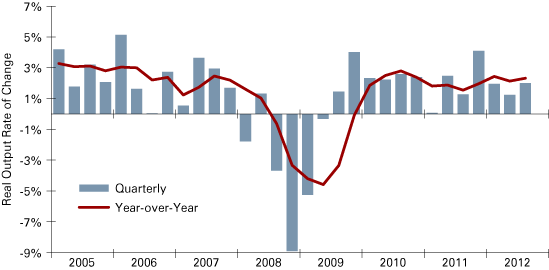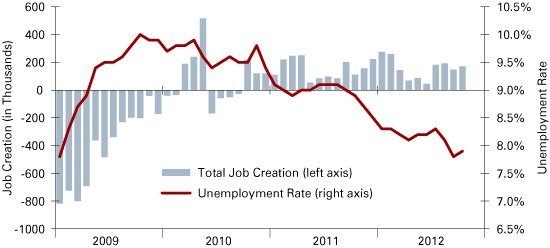U.S. Outlook for 2013
Professor Emeritus, Department of Economics, Indiana University Bloomington
The U.S. economy in 2012 managed to underachieve even relative to our unambitious expectations. A year ago, we thought growth might be a little above 2.5 percent for the year, which would have been a modest improvement from the 2 percent achieved in 2011.
Instead, as shown in Figure 1, through three quarters the economy has expanded at an annual rate of only 1.7 percent. Job creation has been equally disappointing. We anticipated job growth would average close to 170,000 per month. Through October, the actual outcome has been just 157,000 (see Figure 2). The unemployment rate, on the other hand, has come down more than we anticipated—to 7.9 percent in October. A significant drop in the labor force participation rate explains this apparent contradiction. Individuals who stop looking for work (and thus drop out of the labor force) are no longer considered to be unemployed. If such discouraged workers were included, the unemployment rate would be about 1.5 percent higher. In addition, another 5 percent of the labor force who are employed part-time would rather have a full-time job.
Figure 1: U.S. Real Output Rate of Change, 2005 to 2012

Source: Bureau of Economic Analysis
Figure 2: U.S. Job Creation and Unemployment Rate, 2009 to 2012

Source: Bureau of Labor Statistics
Explanations for this depressing situation are not entirely convincing, but a list of usual suspects is available. Part of the problem lies abroad: Europe is making little progress in dealing with its sovereign debt problems, and China is clearly transitioning to a slower growth path. Part of the problem is domestic: The winding down of the stimulus package implied an inevitable shrinkage in the government sector. 2012 will be the third straight year in which government spending on goods and services (not including transfers such as Social Security and Medicare) has declined. The inability of the federal government to reach any firm decisions about tax policy and its budget has created great uncertainty. This uncertainty has left businesses unwilling to hire or invest.
These headwinds are unlikely to disappear in 2013. The problems facing both Europe and China are chronic. The domestic political situation was not clarified by the election, and divided government is still likely to thwart dramatic progress. As a result, we expect that 2013 will be generally similar to 2012: unacceptably slow growth without much progress in the labor market.
The Forecast
We expect output to grow about 2.5 percent on a fourth-quarter to fourth-quarter basis. This will be better than 2012, due to somewhat better household spending, significant improvement in housing and less drag from the government sector.
Employment will continue to increase, but only enough to allow marginal progress in reducing unemployment. By the end of 2013, unemployment will still be above 7 percent.
We expect inflation to remain well contained in 2013.
The housing sector has hit bottom, and the wave of foreclosures is finally starting to recede. During 2013, home prices will be increasing, and new home construction will be a bright spot in the economic landscape.
The Federal Reserve lowered short-term interest rates to virtually zero almost four years ago and has said it will maintain this stance through mid-2015. It has also announced that it will purchase about $40 billion in securities per month for an indefinite period (quantitative easing, aka QE infinity). This is unlikely to have any dramatic positive effect.
Any actions on the federal deficit/debt will be welcome. Inaction would be very counterproductive (more on this below).
So we see continuing tepid economic recovery during 2013, with disappointing output expansion, low inflation and a small decline in unemployment. This is better than a slide back into recession, but is a long way from an optimistic outlook.
The Caveats
Moreover, like a year ago, there is a roster of things that could adversely upset our expectations. In terms of immediacy, the “fiscal cliff” tops the list. Without political compromise—something we have little experience with recently—a long list of tax increases and spending reductions will go into effect on January 2. If a cliff dive does occur, it would almost certainly put the economy back into recession with negative growth for much of next year, with a decline in employment and rising unemployment. In fact, the uncertainty about the situation is already having an impact on business decisions. In the third quarter, investment in plant and equipment actually declined. The tepid pace of hiring probably also reflects this ambiguity.
As mentioned earlier, the external situation is also a minefield. Europe could go critical. The slowdown in China could go critical. The Middle East could go critical.
The Bright Spots
Unlike a year ago, there are also definite bright spots. One is the revival of the housing sector. From its peak in late 2005 to its trough almost five years later, housing activity receded by nearly 60 percent. In 2012 (through the third quarter), however, housing accounted for one-fifth of the overall growth of the economy even though the sector comprises less than 3 percent of GDP. Over the past year (through October), housing starts have increased 35 percent. On a sustained basis, the demand for new housing in the U.S. is at least 1.2 million units. That implies a further increase of about 40 percent just to get to the long-run trend. During 2013, housing should directly contribute a full percent to the overall growth of the economy, with an additional contribution from purchases of furnishings and other associated spending.
A second growth sector—totally unexpected just a few years ago—is energy. As everyone knows, production of oil and natural gas from shale is booming. The economic impact in regions affected is dramatic. North Dakota has an unemployment rate of 3 percent. Ohio (a site of some drilling, but also a lot of associated manufacturing) has the lowest unemployment rate of the Great Lakes states. More than 1 million jobs have been created nationally by the industry. There are also enormous potential indirect effects. The supply glut has drastically lowered natural gas prices. This is nice for homeowners who heat with gas and a potential game-changer for energy intensive industries—not to mention those that use gas as a raw material (e.g., chemical producers).
Housing and energy provide a base on which a solid expansion could take shape. At a minimum, they provide a barrier against a slide back into recession. But the heart of the economy is still consumer spending and business investment. Both these areas are being held back by the pervasive uncertainty emanating from government policy and the international situation. As long as that persists, the most likely course for the economy is continued slow growth.
Also in this Issue…
- International Outlook for 2013
- U.S. Outlook for 2013
- Financial Outlook for 2013
- Indiana's Outlook for 2013
- Indiana's Agricultural Outlook for 2013
- Three Key Indicators—Forecasts for Jobs, Income and Productivity
- Anderson Forecast 2013
- Bloomington Forecast 2013
- Columbus Forecast 2013
- Evansville Forecast 2013
- Fort Wayne Forecast 2013
- Gary Forecast 2013
- Indianapolis-Carmel Forecast 2013
- Lafayette Forecast 2013
- Louisville Forecast 2013
- Muncie Forecast 2013
- Richmond Forecast 2013
- South Bend and Elkhart Area Forecast 2013
- Terre Haute Forecast 2013




